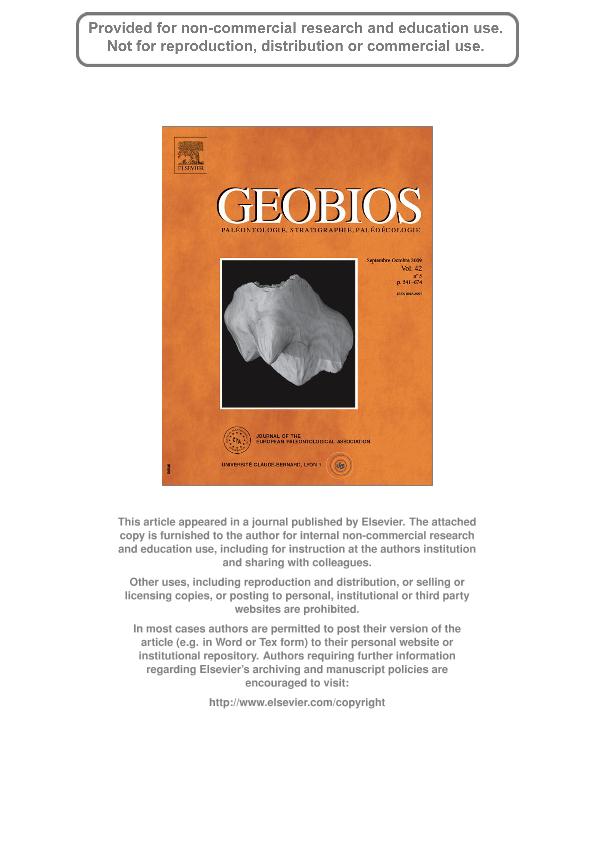Artículo
Una nueva especie de Neuryurus Ameghino (Mammalia, Glyptodontidae) en el Pleistoceno tardío de la Mesopotamia de Argentina
Título:
A new species of Neuryurus Ameghino (Mammalia, Glyptodontidae) from the late Pleistocene of the Mesopotamic region of Argentina;
Une nouvelle espèce de Neuryurus Ameghino (Mammalia, Glyptodontidae) du Pléistocène supérieur de la région Mésopotamique d’Argentine
Une nouvelle espèce de Neuryurus Ameghino (Mammalia, Glyptodontidae) du Pléistocène supérieur de la région Mésopotamique d’Argentine
Fecha de publicación:
09/2009
Editorial:
Elsevier France-editions Scientifiques Medicales Elsevier
Revista:
Geobios
ISSN:
0016-6995
Idioma:
Español
Tipo de recurso:
Artículo publicado
Clasificación temática:
Resumen
Among the South American Pleistocene Glyptodontidae (Xenarthra, Cingulata), one of the most scarcely represented genus in the fossil record is Neuryurus Ameghino, in which the only well characterized species, until now, is Neuryurus rudis (Gervais), coming from the Ensenadan (early-middle Pleistocene) of the Pampean region, Argentina. In this contribution, we report and describe a new species of Neuryurus, coming from the Arroyo Feliciano Formation (early Lujanian; ca. 130 ka), Entre Ríos province, Argentina, in a particular palaebiogeographic context, more associated with the western sector of Uruguay and southern Brazil than the Pampean region. From a morphological perspective, this new taxon is characterized by: (a) the remarkable development of the foramina at the exposed surface of the osteoderms of the dorsal carapace, showing un aspect almost spongy; (b) the large diameter of the perforations observed in the ventral surface of the osteoderms, resembling to those present in the dorsal surface of the osteoderms of the Glyptodontidae Doedicurinae; (c) the evident thickness of the osteoderms, as in Glyptodon Owen; (d) area of contact and articulation of adjacent osteoderms very denticulate, with deep osseous interdigitating projections, as in Glyptodon and Glyptotherium Osborn, but here more evident; (e) larger osteoderms of the dorsal carapace showing, in the dorsal surface, many little conical tubercles, having some resemblance to Panochthus tuberculatus Burmeister. The presence of this new species in the early late Pleistocene of the Mesopotamic region is another element that adds to the biogeographical characterization of this particular area, especially evident during the warm and humid pulses of the late Pleistocene. In turn, this species represents the most complete record of the genus outside the Pampean region and partially complete the stratigraphic and geographic distribution of the genus.
Palabras clave:
Biogeography
,
Cingulata
,
Lujanian Stage
,
Mesopotamic Region
,
Neuryurini
,
Taxonomy
Archivos asociados
Licencia
Identificadores
Colecciones
Articulos(CECOAL)
Articulos de CENTRO DE ECOLOGIA APLICADA DEL LITORAL (I)
Articulos de CENTRO DE ECOLOGIA APLICADA DEL LITORAL (I)
Articulos(CICYTTP)
Articulos de CENTRO DE INV.CIENT.Y TRANSFERENCIA TEC A LA PROD
Articulos de CENTRO DE INV.CIENT.Y TRANSFERENCIA TEC A LA PROD
Citación
Zurita, Alfredo Eduardo; Ferrero, Brenda Soledad; Una nueva especie de Neuryurus Ameghino (Mammalia, Glyptodontidae) en el Pleistoceno tardío de la Mesopotamia de Argentina; Elsevier France-editions Scientifiques Medicales Elsevier; Geobios; 42; 5; 9-2009; 663-673
Compartir
Altmétricas




